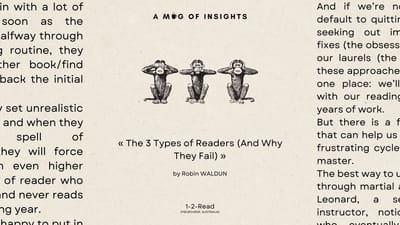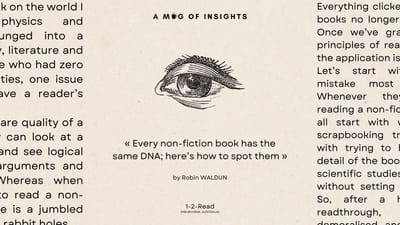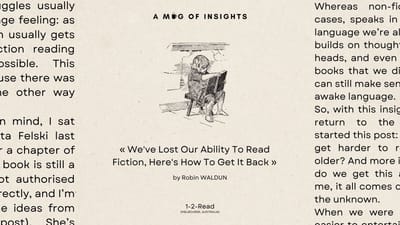[1-2-Read] Speed-Reading Is BS. Here's What Actually Works
![[1-2-Read] Speed-Reading Is BS. Here's What Actually Works](/content/images/size/w1920/2025/08/Speed-Readin.jpg)
(1) The Idea: Speed-Reading Techniques Are BS
I find it interesting that when my friends ask about my reading habits, they always start with: Robin! How do you read so much so fast? And when they have a go at bringing reading back into their lives, they always complain about how slow they’re going. I only read 5 pages in an hour!
I think it’s a metric problem. Reading books, unlike checking off an item on your to-do list, doesn’t have hard starts and stops to give you a rush of accomplishment. It’s open-ended, slow and cannot be tracked on a spreadsheet. So, to feel like we’re not wasting our time, we use quantifiable metrics like WPM and pages we’ve read instead of focusing on how well we’re reading.
This is why speed-reading classes are attractive to people who are just getting started. They sell them the idea of reading 100 books a year that lends them a quantifiable bragging point. They teach these elaborate eye movements and hacks that stop you from sounding the words out in your head. But none of these classes ever pay attention to the only thing that matters in reading: understanding the damn book.
Now, this post isn’t here to shit on speed-reading. In fact, I think these techniques are valid and they work, but how they work might not be what you’ve expected. So, grab your ever-expanding TBR, a pencil and get comfortable. Let’s demystify speed-reading and get it to work in the proper way.
Something strange I noticed lately
I recently bought a copy of The Savage Detectives on a whim and started reading it one evening after work. This is that kind of novel that grips you by the throat and pulls you along for a wild ride. After disappearing into the novel for a while, I realised that I’d read nearly 50 pages in a short span of 20 minutes.
Mind you, I wasn’t paying attention to common speed-reading practices like: mind your eye movements, trace the words with a pencil or silence your thoughts. I was just hanging out at my usual café, trying to unwind after a day of work. But one thing I have noticed myself doing is that my reading speed ebbs and flows. I would speed up if I’m reading a giant page of background descriptions, and slow down whenever someone’s giving away a major plot point. There was no uniform speed or a set WPM, but a series of starts and stops like driving in rush hour traffic.
It's not about speed
Reading faster, at least in my experience, has nothing to do with pushing yourself up to a set speed or a prescribed number of pages. It actually has a lot more to do with knowing when to speed up and knowing when to slow down. But for newcomers, it’s hard to know how to tell a slow moment from a fast one, so they either become scrapbookers, where they try to hold on to everything, or horseback botanists, where they try to race through a field of writing without ever slowing down.
The happy medium is being able to modulate your speed according to your needs, and in order to do this, we need to focus on the boring basics: comprehension and coherence.
First C: Comprehension
Subscribe to continue reading



